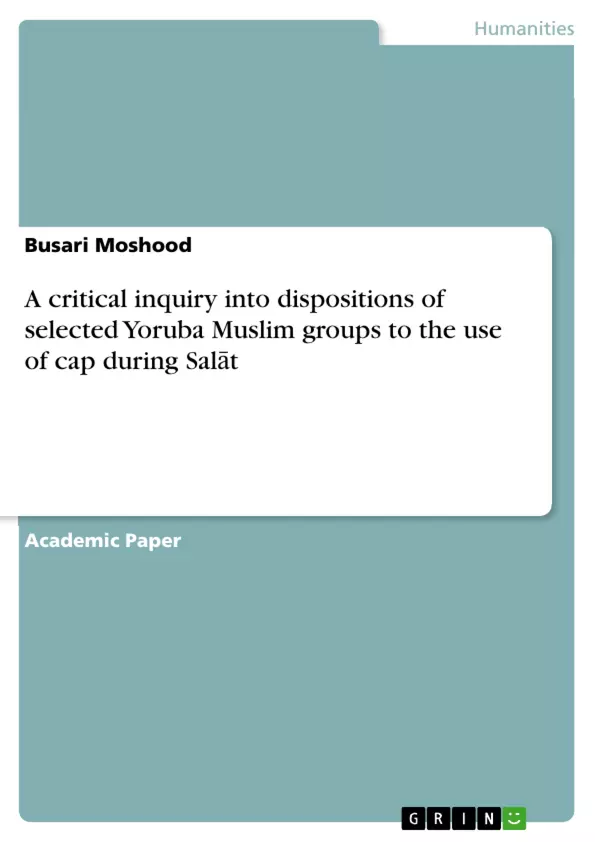Controversies over religious issues are not only interdenominational as they can also be intra-faith. These arise from concepts and matters that are crucial to better understanding of a particular religion and effective discharge of one’s obligations as an adherent of such a religion. Such issues which abound in Islam include those on religious identifiers such as the cap and the Hijāb. A lot has been written on the Ḥijāb, Niqāb and Khimār as an identifier of a female Muslim without giving attention to the cap which is identified with her male counterpart. This study therefore probed into controversies expressed by some selected Yoruba Muslim groups on the use of cap during Ṣalāt. This is with a view to ascertaining the right perspective of Islam on the position of cap in Ṣalāt. The study employed purposive sampling technique in selecting thirteen (13) scholars for interviews from six out of the eight sampled Muslim groups which are the Tijāniyyah, the Qādiriyyah, the Muslim Students’ Society of Nigeria (MSSN), the Muslim Congress (TMC), Tacāwunul- Muslimīn , the Tablīgh Brotherhood, the Izālah and the Zumrah. Also, two thousand four hundred and seventy (2,470) members of these eight groups were randomly sampled as questionnaire respondents. The data generated from the respondents’ responses was analysed in Chi square and simple percentages using SPSS while their views were critically examined using the Qur’ān and Sunnah. In spite of inter-group differences noticed in the expressed views, there were also intra-denominational disagreements which point to the elasticity and flexibility of Islamic Jurisprudence on non-fundamental issues (furūc ) Such as this. As such, differences in the juristic views expressed on the use of the cap during Ṣalāt should be utilized by Muslims to facilitate better understanding of Islam on them rather than allowing it to breed disunity and disharmony , considering the fact that the head is not the part of the ‘awrah which must be covered by a male worshipper in Ṣalāt.
Inhaltsverzeichnis (Table of Contents)
- Abstract
- Keywords
- Background to the Study
- Related Literature
- Statement of the Problem
- Research Methodology
- Yoruba Muslims and the use of Cap During Salāt
Zielsetzung und Themenschwerpunkte (Objectives and Key Themes)
This study examines controversies among selected Yoruba Muslim groups regarding the use of a cap during Ṣalāt, aiming to determine the correct Islamic perspective on this practice. The study utilizes interviews and questionnaires to gather data from members of various Islamic groups, analyzing the responses through the lens of the Qur'ān and Sunnah.
- Controversies surrounding the use of a cap during Ṣalāt among Yoruba Muslim groups
- Islamic perspectives on religious identifiers, particularly the cap
- The significance of the cap in worship and its role as a symbol of Islamic identity
- The application of Islamic jurisprudence (furu) to non-fundamental issues
- Inter-group and intra-denominational differences within Islamic practice
Zusammenfassung der Kapitel (Chapter Summaries)
- The abstract presents the research topic, methodology, and key findings, highlighting the controversies surrounding the use of a cap during Ṣalāt.
- The "Background to the Study" section explores the significance of Islamic identifiers, particularly the cap, and its perceived role in signifying Muslim identity.
- The "Related Literature" chapter provides an overview of the origins and types of Islamic caps, discussing their historical and cultural significance.
- The "Statement of the Problem" section outlines the research question, emphasizing the lack of scholarly attention on the use of the cap during Ṣalāt.
- The "Research Methodology" chapter details the qualitative and quantitative approaches employed in the study, including sampling techniques and data analysis methods.
- The "Yoruba Muslims and the use of Cap During Salāt" segment delves into the diverse views expressed by different Islamic groups regarding the use of a cap during prayer.
Schlüsselwörter (Keywords)
This study examines Yoruba Muslim groups, controversies, religious identifiers, juristic views, and the concept of 'awrah in relation to the use of a cap during Ṣalāt. It explores the intersection of religious practice, cultural identity, and Islamic jurisprudence in the context of specific Islamic groups.
- Citar trabajo
- Dr. Busari Moshood (Autor), 2022, A critical inquiry into dispositions of selected Yoruba Muslim groups to the use of cap during Salāt, Múnich, GRIN Verlag, https://www.grin.com/document/1183764



